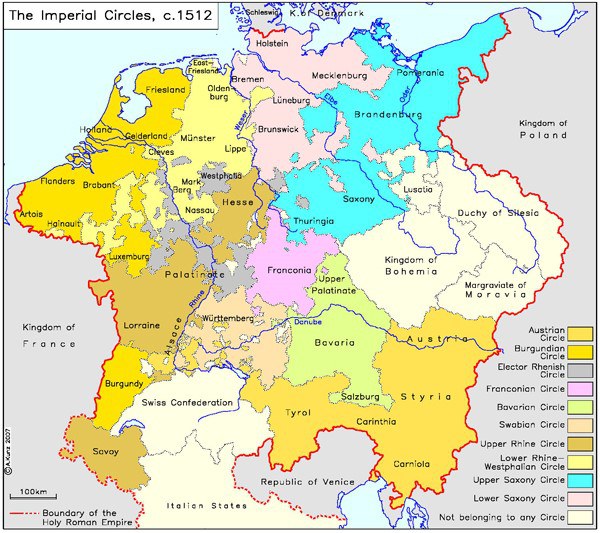Anne of Cleves: Life Story
Chapter 1: Cleves
Anne (whose given name was Anna), was probably born in the ancient fortress of Düsseldorf, in the duchy of Cleves-Jülich-Berg, usually shortened to ‘Cleves’. The duchy had been created by the marriage of Anne’s mother, Maria, Duchess of Jülich-Berg, and her father, Johann III, Duke of Cleves, and the states were formally united in 1521 when Anne’s paternal grandfather died. The territories were all located within the Holy Roman Empire, that loose agglomeration of states that stretched from the Baltic to the Italian peninsula, under the titular headship of the Holy Roman Emperor, whose prestige was always greater than his power.
The court of Cleves in the late fifteenth and early sixteenth centuries was heavily influenced by that of Burgundy, considered the epicentre of culture – Anna’s paternal grandfather certainly enjoyed the more romantic aspects of mediaeval and renaissance culture, siring no fewer than sixty-three illegitimate children, as well as his legitimate son, and a daughter, another Anna.
Anne was the second child of four. She had an older sister and a younger, Sibylle and Amelia, and a brother, Wilhelm. So far as Anne’s education is concerned, more is known of what she was not taught, than what she did learn. Her education was supervised by her mother, who was later described as extremely pious. Duchess Maria ensured that her daughters learnt all the traditional skills of high-born ladies – housekeeping, cookery, management of a home and estate, and to read and write in their own language. She did not, however, embrace the courtly education that princesses in other parts of Europe were being given – a knowledge of foreign languages, music, dancing and favourite courtly pastimes such as cards, dice and the writing of verse – it was considered unseemly for noblewomen in Germany to perform musically themselves. Like the other young ladies of the court, Anne spent most of her time secluded in the women’s quarters, and Duchess Maria was described as ‘one that looketh very straitly to her children’.
Duke Johann, influenced by Erasmus, was more tolerant of religious difference than most of his contemporaries. Whilst remaining within the Catholic fold doctrinally, he was tolerant of the growing presence of Lutheranism in and around his duchies, and in 1533, consulted Erasmus on the implementation of church regulations, having repudiated the authority of the pope. He extended a hand to the Lutherans, arranging for the marriage of Anne’s elder sister, Sibylle, to Johann-Friedrich of Saxony, who was later to lead the Schmalkaldic League – a group of German states which accepted the Lutheran Confession of Augsburg. Nevertheless, Anne and her siblings were brought up in the Catholic faith, their mother being conservative in religion.
In 1527, aged twelve, Anne was betrothed to eight-year-old Francis, son of the Duke of Lorraine. (Francis’s sister, Marie, was later to marry James V of Scotland). Since he was not of age to contract a legal marriage, this betrothal was probably ‘de futuro’ and did not have the validity of marriage. Such an arrangement could be rescinded, although a formal dispensation was required to allow marriage to other parties.
Anne’s quiet upbringing was in contrast to the turmoil that convulsed much of Germany during her childhood. The German Peasants’ War, which broke out in 1524, devastated many lands. As many as 300,000 Germans had been killed. Cleves itself was in contention with the Emperor, Charles V, over the duchy of Guelders. Anne’s brother, Wilhelm, had been recognised by the Guelderians as their duke in 1538, on the death of his distant cousin, Charles of Egmond, Duke of Cleves, as a collateral descendant of Reginald I of Guelders. The emperor claimed the duchy, because his great-grandfather, Charles the Bold of Burgundy, had purchased its reversion from Duke Arnold back in the 1470s, although the sale can hardly have been said to be willing on Arnold’s part. Emperor Charles was sensitive to the increase in power of the Cleves duchies, as control of Guelders would give them access to the sea, enabling them to control commerce along the Lower Rhine.

It was this desire to stand up to the Empire that made Cleves of interest to England as a potential ally. By 1538, Henry VIII had, over the course of his reign, been allied with France against the emperor, but more frequently with the emperor against France and much of his foreign policy involved playing one off against the other. He was now faced with the prospect of King François and Emperor Charles sinking their differences and combining against him. This threat, which had England on the alert for an invasion in the Channel, was the background to the Exeter Conspiracy.
Advised primarily by Thomas Cromwell, Henry began to look about for ways to undermine the Franco-Imperial alliance. By this time, he was a widower, his third wife, Jane Seymour, having died in 1537, after giving birth to Prince Edward. He also had three children, Mary, Elizabeth and Edward, which gave him four cards to play in the game of international alliance-by-marriage. He made overtures to France, particularly for Marie of Guise, who was already promised to James V of Scotland, and was less than eager to marry the king of England. He was particularly enamoured of the idea of Christina of Denmark, the sixteen-year-old, recently widowed duchess of Milan, the Emperor’s niece (and incidentally the great-niece of Henry’s first wife, Katharine of Aragon). Charles toyed with the idea, and, had he really wished such a marriage to take place, it is unlikely that Christina’s own disinclination would have been taken into account, but the Emperor was merely trying to prevent any French marriage.
An alliance with the Protestant states of Germany was therefore considered a good option – it would aggravate Charles, and hopefully divert his mind from invading England. Cleves was not part of the Schmalkaldic League, but closely connected to it.
